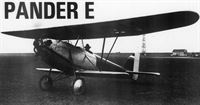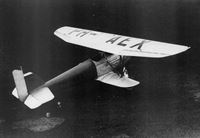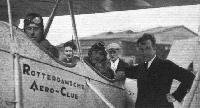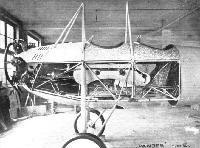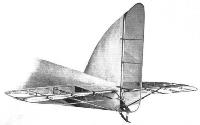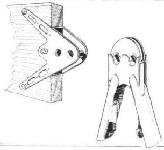
Flight, April 1926
THE PANDER LIGHT BIPLANE
A School Two-Seater with 45 H.P. Anzani Engine
AFTER the success which attended the production of the light monoplane with 30 h.p. Anzani engine, which was exhibited at the last Paris Aero Show, and of which several specimens have from time to time visited this country, it is not surprising that Mr. H. Pander of The Hague, should have turned his attention to a two-seater. When we visited the Pander Works last summer we had an opportunity of seeing the sketch design for the two-seater and also some of the parts which were then in course of manufacture at the Pander works. The machine, known as the Type E, has now been finished and was tested recently by Lieutenant Elkerbout of the Dutch Navy. The machine was found to be perfect as regards trim, and during a preliminary test flight the manoevrability was proved to be excellent. Later in the day a number of passengers were given their bapteme de fair in the Pander, among them being Mr. Pander senior, who, although he has been an aviation enthusiast for several years, has not hitherto made a flight, the reason presumably being that hitherto his firm has produced single-seaters only.
The Pander type E, it will be seen from the accompanying illustrations, is a biplane having a very small lower plane. In other words it is of the type which has come to be described as a sesquiplan, or one-and-a-half plane. An unusual feature of the machine is the type of wing bracing employed. In order to keep the wing weight down, and also to facilitate storage and transport, it was decided not to make the top plane a pure cantilever, but as it was desired to keep the external members of the wing bracing structure down to a minimum a rather unusual form of wing bracing, shown in the illustrations, was evolved. The top plane is built in two halves, pin-jointed at the centre to the cabane legs rising from the top longerons of the fuselage. Each wing half is supported by a pair of inter-plane V-struts, and the lift is taken by a single strut sloping outwards from the top longerons of the fuselage to the foot of the V struts where these meet the lower plane. In normal straightforward flying, therefore, the V-struts are working in tension, and it is only at attitudes causing large movements of the centre of pressure that any of these struts have to resist compression loads. It would appear likely that owing to the relatively flat angles very considerable compression loads may be present in the single sloping lift struts, but doubtless these have been built of sufficiently heavy-gauge, steel tubes to carry the loads imposed upon them and we are informed that the machine has been designed with a factor of safety of 74, so as to be eligible for its aerobatics airworthiness certificate. For the rest the Pander Type E shows very clean lines, and the view from both cockpits should be excellent, except in an upward direction, as the lower plane is of such small chord (2 ft. 9 in.) that it can scarcely obstruct the view from the rear cockpit to any material extent.
Constructionally the Pander Type E is of composite type, wood being the material used exclusively in the wing construction and also in the rear portion of the fuselage, while the rest of the machine, i.e., front portion of fuselage and the rudder and elevator, are of welded steel tube construction. The upper wing, which has a span of 32 it. 10 in. and a maximum chord of 5 ft. 3 in., is built up on two main spars of box section, with spruce flanges and three-ply walls. The ribs are of three-ply, the top plane being further stiffened by having the whole leading edge, back to some distance aft of the front spar, covered with three-ply. The lower plane, which has a span of 16 ft. 5 in. has a single box spar, which measures 8 in. in width and just over 5 in. in depth. This box spar is built up of spruce and three-ply and the wing is further stiffened by a three-ply covering over the leading edge, forming yet another box spar. The covering of the wings is fabric, except over the centre portion of the top plane, in which are housed the two petrol tanks (each with a capacity of 7 1/2 gallons), which is covered with three-ply. The interplane V-struts and the single lift struts are of streamlined steel tube and the rear strut of the V's has provision for adjustment of its length for the purpose of trueing-up.
The fuselage, which is of oval cross-section, is built in two halves, of which the front portion is of welded steel tube construction, the bracing being in the form of diagonal tubes as regards the forward panels, but having piano-wire bracing in the side panels in way of the pilot's cockpit. The rear portion of the fuselage is of similar construction to that of the Pander single-seater, i.e., light formers and stringers covered with plywood. The two fuselage portions are joined together at four points, where long fish-plates extend aft from the steel tube longerons to form a joint with the wooden longerons of the rear portion. These fish-plates may be seen in some of the photographs.
The machine is equipped with dual controls, consisting of the usual joy-stick for elevator and ailerons, but having pedals in place of the more usual foot-bar for the rudder, the pedals being more convenient in a machine in which space, and particularly width, is restricted.
The 45 h.p. 6-cylinder Anzani engine is attached at four points to the main structure of the fuselage, and a fireproof bulkhead is interposed between the engine and the front cockpit. The whole of the front portion of the fuselage is covered with sheet aluminium. As already mentioned the petrol tanks are carried in the top plane, so that direct gravity feed can be employed, and the petrol system is such that the fuel can be taken from either tank or from both tanks simultaneously.
The undercarriage is of streamlined steel tubes, with the axle working in a slot in the vertical strut, and anchored in such a way by rubber cord shock-absorbers that not only can it travel up and down but is also free to move to a considerable extent laterally. The front undercarriage strut runs to the top longeron of the fuselage, while the rear strut runs to the lower longeron, the V thus formed being braced laterally, not by cables or streamlined wires as is usually done, but by short steel tube struts, sloping to the centre line of the bottom of the fuselage.
As in the Pander monoplane, the fin and tail plane are entirely of wood construction, covered with plywood and built into the fuselage. The rudder and elevator have steel tube leading edges and welded sheet-steel ribs. In order to facilitate taxying, the tail skid is mounted on and turns with the rudder, the method of mounting it in the rudder being shown in one of the photographs.
Following is a brief specification of the Pander type E: Weight empty, 702 lbs.; total loaded weight (pilot, passenger, and 4 hours' fuel). 1,180 lbs.; total wing area, 190 sq. ft.; wing loading, 6-2 lbs./sq. ft.; engine, 45 h.p. Anzani, developing normal power at 1,500 r.p.m., and a maximum of 50 h.p. at 1,580 r.p.m.; power loading (on normal speed), 26-2 lbs./h.p.; maximum speed, 78 m.p.h.; cruising speed, 72 m.p.h.; landing speed, 38 m.p.h.; climb to 3,000 ft. in 7 3/4 mins. Ceiling 11,500 ft.
- Flight, April 1926
THE PANDER LIGHT BIPLANE
Фотографии
-
Flight 1926-04 / Flight
Регистрационный номер: H-NADI [4] THE PANDER TYPE E LIGHT 'PLANE: Three-quarter front view. The engine is a 45 h.p. Anzani. Note the unusual wing bracing.
The prototype Pander E, H-NADI, made its first flight on February 18, 1926 from Waalhaven Airport, near Rotterdam. -
Aeroplane Monthly 1989-01 / H.Hazewinkel - The aeroplane that taught Holland how to fly. Pander E
Регистрационный номер: PH-AEV One of the last Pander ECs built was PH-AEV, registered on November 3, 1928. It was given the name Grey Redstart, presumably because of its colour scheme.
-
Flight 1926-04 / Flight
Регистрационный номер: H-NADI [4] THE PANDER TYPE E LIGHT BIPLANE: Three-quarter Rear View.
Another view of the Pander E prototype, H-NADI. -
Aeroplane Monthly 1989-01 / H.Hazewinkel - The aeroplane that taught Holland how to fly. Pander E
Регистрационный номер: H-NADI [4] This side view of the prototype Pander E shows the clean lines of the attractive sesquiplane.
-
Aeroplane Monthly 1989-01 / H.Hazewinkel - The aeroplane that taught Holland how to fly. Pander E
Регистрационный номер: H-NAEJ Pander EC H-NAEJ was rebuilt in 1933 as a Pander EK, fitted with an Armstrong Siddeley Genet engine.
-
Flight 1927-08 / Flight
Регистрационный номер: H-NADV [2], H-NADW [3] HOLLAND'S FIRST LIGHT 'PLANE CLUB: The example of Great Britain in forming Light Aeroplane Clubs is being followed in other countries. One of the latest to be formed is the "Rotterdamsche Aero Club, " and for a start two machines have been purchased. These are Pander biplanes of the type EC, fitted with 60-70 h.p. Walter engines. Their registration letters are H-NADV and H-NADW respectively.
-
Aeroplane Monthly 1989-01 / H.Hazewinkel - The aeroplane that taught Holland how to fly. Pander E
Регистрационный номер: PH-AEX [2] The final Pander EC was PH-AEX, seen here after it was repaired following a crash. It was subsequently sold to NLS in October 1929.
-
Aeroplane Monthly 1989-01 / H.Hazewinkel - The aeroplane that taught Holland how to fly. Pander E
Регистрационный номер: PH-AET, PH-AEX [2] Pander E PH-AET(PH-AEX) was painted as a cigar - it was owned by a company selling SOPLA cigars.
-
Aeroplane Monthly 1989-01 / H.Hazewinkel - The aeroplane that taught Holland how to fly. Pander E
Регистрационный номер: PH-AIB Pander EF-85 PH-AIB as used by the NLS at Twente. Named De Kiefte, 'IB survived until 1940.
-
Aeroplane Monthly 1989-01 / H.Hazewinkel - The aeroplane that taught Holland how to fly. Pander E
Регистрационный номер: PH-AKA Pander EF PH-AKA was built with an 85 h.p. Walter Vega engine and was registered in April 1930. It survived until destroyed in a crash in September 1936.
-
Aeroplane Monthly 1989-01 / H.Hazewinkel - The aeroplane that taught Holland how to fly. Pander E
Регистрационный номер: PH-AIA Pander EF PH-AIA of the NLS, later re-engined with a Genet engine and destined to survive until the outbreak of war.
-
Flight 1933-09 / Flight
Регистрационный номер: PH-AFZ [2] AIR TOUR OF HOLLAND: The start from the Waalhaven aerodrome, Rotterdam. The first machine can be seen in the air.
-
Flight 1934-09 / Flight
Регистрационный номер: PH-AFZ [2] Mr. Sluyter flew crazily, running along the ground on one wheel, dropping to the ground in an almost stalled condition and demonstrating the "handlability" of his Pander (Siddeley "Genet").
-
Flight 1929-07 / Flight
"OVER THE TAPE" AT ROTTERDAM: One of styles in the take-off tests - One of the Club Panders.
-
Flight 1929-07 / Flight
"FORMATING" AT ROTTERDAM: The three little Club Panders taking off.
-
Flight 1929-04 / Flight
The arrival of the first Pander biplane from Rotterdam
-
Flight 1928-07 / Flight
Регистрационный номер: H-NADW [3] AT THE ROTTERDAM LIGHT 'PLANE MEETING: The take-off and landing competition. 3. One of the Panders doing the landing.
-
Aeroplane Monthly 1989-01 / H.Hazewinkel - The aeroplane that taught Holland how to fly. Pander E
Регистрационный номер: H-NADV [2] H-NADV, one of the Panders used by the Rotterdam Aero Club, over the port of Rotterdam.
-
Flight 1928-07 / Flight
The right spirit: Trying out each other's machines was a favourite pastime at Waalhaven. Lady Heath is here seen after a flight in one of the Pander machines. In the front cockpit is M. Schmidt Crans, and standing by the side of the machine, M. Slot, constructor of the Pander aeroplanes.
-
Flight 1928-07 / Flight
THE D.C.A. AT WAALHAVEN: Sir Sefton Brancker paid a visit to the Rotterdam Meeting on Sunday last, arriving with a party on a Fokker placed at his disposal by the K.L.M. He is here seen, in front of one of the Pander machines with, among others, M. C. Kolff, Miss O'Regan, M. Schmidt Crans and M. de Niet.
-
Flight 1929-04 / Flight
DUTCH TEAM AT LYMPNE: (Left to right) Mijnheer G. Gleichman, Mijnheer L. M. Redele, Mijnheer H. Pander, Mijnheer Schmit Crans, Mijnheer Vlaming and Mijnheer Van Troostenburg.
-
Flight 1928-07 / Flight
A TEAM IN THE RELAY RACE: In the foreground, Lady Heath's "Cirrus-Moth." In the centre, the Demonty-Poncelet, and in the background one of the Pander machines.
Другие самолёты на фотографии: De Havilland Moth / D.H.60 - Великобритания - 1925
-
Flight 1926-04 / Flight
Регистрационный номер: H-NADI [4] Front portion of the Pander light biplane, showing seating accommodation, etc. This portion of the fuselage is of welded steel tube construction. Note the attachment for the single spar of the lower plane.
The prototype Pander E, H-NADI, photographed during construction at the factory at the Zuid-Binnensingel in The Hague in 1926. -
Flight 1926-04 / Flight
The tail of the Pander light biplane is partly of steel tubular construction. The tailskid is mounted on, and moves with, the rudder.
-
Flight 1930-10 / Flight
Регистрационный номер: PH-AFN [3] The Pander biplane, fitted with a D.H. "Gipsy I" engine, on which Mr. Van Tijen is to attempt a flight to the Dutch East Indies. It has an all-steel body, metal airscrew, and Bendix wheels and brakes.
-
Aeroplane Monthly 1989-01 / H.Hazewinkel - The aeroplane that taught Holland how to fly. Pander E
Регистрационный номер: PH-AFN [3] Pander EG PH-AFN Adelaar was used by van Tijen for his Amsterdam-Batavia flight in October 1930.
-
Flight 1938-02 / Flight
Регистрационный номер: PH-AFM Ground instruction: A group of future K.L.M. pilots with one of the Panders used by the National Flying School.
-
Flight 1931-01 / Flight
Регистрационный номер: PH-AFN [3] CLEAN LINES: A front view of Mr. Van Tyen's Pander (Gipsy I) showing lines very reminiscent of the Fokker Fighters.
-
Aeroplane Monthly 1989-01 / H.Hazewinkel - The aeroplane that taught Holland how to fly. Pander E
Регистрационный номер: PK-SAJ [3] The Surabaya Aero Club's second Pander EG, PK-SAJ Kolibrie, operated in the Dutch East Indies until crashed in April 1939.
-
Flight 1934-01 / Flight
Регистрационный номер: PK-SAJ [3] FROM THE DUTCH INDIES: The first Miles "Hawk" (extreme right) put into service at the Sourabaya Aero Qub, where it is giving great satisfaction.
Другие самолёты на фотографии: Miles Hawk / M.2 - Великобритания - 1932
-
Air-Britain Archive 1982-03
Регистрационный номер: PK-SAJ [3] Very much a where and when problem. Desoutter G-AAWT was sold to the Dutch East Indies in 10.33 then regd PK-SAN to a Surabayan company 27.12.33. DH.60M PK-SAF was based at Surabaya from 3.8.33, as was Pander EG-100 PK-SAJ from 6.2.33. It would seem that the photo must have been taken in late 1933 at Surabaya, NEI. (Credit H.Hazewinkel in Digest Nov/Dec 1978) The KNILM Fokker F.VIIB may be PK-AFG from evidence on the original print.
Harm Hazewinkel informs us that Desoutter G-AAWT arrived at Surabaya 11.33 and was assembled at Morokrembangan Naval Air Base - which may be where the photo was taken although the KNILM Fokker would be more likely to be found at the civil airfield at Darmo.Другие самолёты на фотографии: De Havilland Gipsy Moth / Moth X - Великобритания - 1928Fokker F.VII / C-2 / F.XIV - Нидерланды - 1924Koolhoven FK-41 - Нидерланды - 1928
-
Flight 1931-01 / Flight
A GIPSY FLIGHT: As reported in "FLIGHT" December 12, Mr. J. E. Van Tyen, a member of the well-known firm of Van Houten, recently flew from Holland to the Dutch East Indies in a Pander. The view shows this machine during construction.
-
Aeroplane Monthly 1989-01 / H.Hazewinkel - The aeroplane that taught Holland how to fly. Pander E
Регистрационный номер: PH-AFP The last development of the Pander E series, the 120 h.p. Gipsy-engined PH-AFP. It was later re-registered PH-AIT.
-
Aeroplane Monthly 1989-01 / H.Hazewinkel - The aeroplane that taught Holland how to fly. Pander E
Регистрационный номер: PH-AIT A line-up of Panders (we can't find the collective noun for pandas - is it a pandemonium, perhaps?) with the Gipsy-engined Pander EH PH-AIT in the foreground.
-
Flight 1926-04 / Flight
Attachment of upper wing spar to cabane.
-
Aeroplane Monthly 1989-01 / H.Hazewinkel - The aeroplane that taught Holland how to fly. Pander E
Pander Type E 45 hp "Anzani" Engine
- Фотографии

